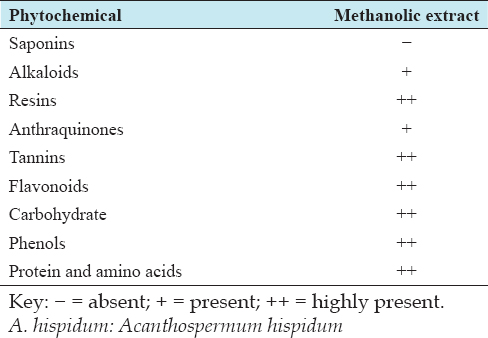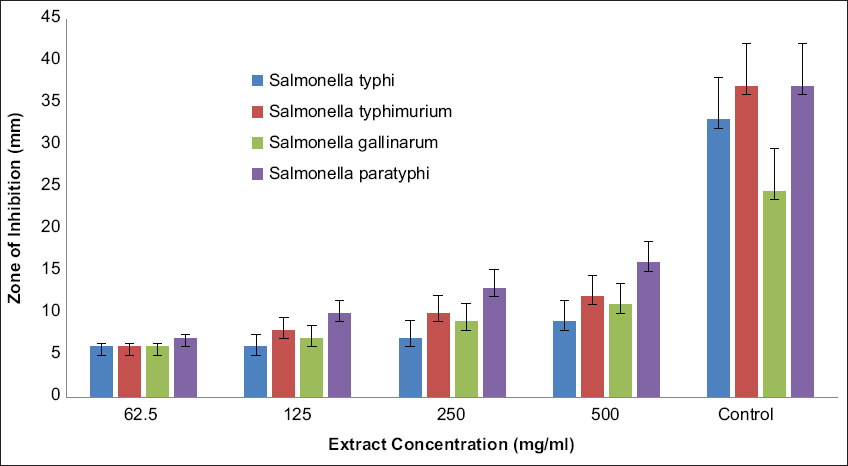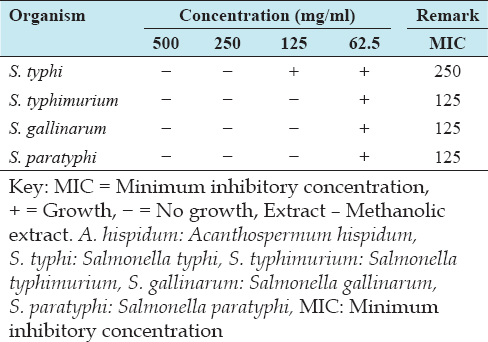1. Ncube NS, Afolayan AJ, Okoh AI. Assessment techniques of antimicrobial properties of natural compounds of plant origin:Current methods and future trends. Afr J Biotechnol 2008;7:1797-806.
2. Prakash D, Gupta KR. The antioxidant phytochemicals of nutraceutical importance. Open Nutr J 2009;2:20-35.
3. Li XZ, Ma D, Livermore DM, Nikaido H. Role of efflux pump(s) in intrinsic resistance of Pseudomonas aeruginosa:Active efflux as a contributing factor to beta-lactamase resistance. Antimicrob Agents Chem 1994;38:1742-52.
4. Levy SB, Marshall B. Antibacterial resistance worldwide:Causes, challenges and responses. Nat Med 2004;10:S122-9.
5. Pamplona-Zomenhan BC, Pamplona CB, da Silva MC, Mimica LM. Evaluation of the in vitro antimicrobial activity of an ethanol extract of Brazilian classified propolis on strains of Staphylococcus aureus. Braz J Microbiol 2011;42:1259-64.
6. Keita SM, Vincent C, Schmit JP, Belanger A. Essential oil composition of Ocimum basilicum, Ocimum gratissimum and Ocimum suave in the republic of guinea. Flavour Fragrance J 2000;15:339-41.
7. Mann A, Salawn FB, Abdulrauf I. Antibacterial activity of Bombax buonopozense P. Beauv. (Bombacaceae) edible floral extracts. Eur J Sci Res 2011;48:627-30.
8. Policegoudra RS, Abiraj K, Gowda DC, Aradhya SM. Isolation and characterization of the antioxidant and antibacterial compound from the mango ginger (Curcuma amada Roxb.) rhizome. J Chromatogr B Analyt Technol Biomed Life Sci 2007;852:40-8.
9. Chattopadhyay D, Arunachalam G, Mandal AB, Sur TK, Mandal SC, Bhattacharya SK. Antimicrobial and anti-inflammatory activity of folklore:Mallotus peltatus leaf extract. J Ethnopharmacol 2002;82:229-37.
10. Tyagi R, Sharma G, Jasuja ND, Menghani E. Indian medicinal plants as an effective antimicrobial agent. J Crit Rev 2016;3:69-71.
11. Akobundu IO, Agyakwa CW. A Handbook of West African Weeds. 2nd ed. Ibadan, Nigeria:ITA;1998. 160-1, 194-5.
12. Chakraborty AK, Gaikwad AV, Singh KB. Phytopharmacological review on Acanthospermum hispidum. J Appl Pharm Sci 2012;2:144-8.
13. Okoro IO, Inegbedion AO, Okoro EO. Phytochemical screening and antibacterial activity of different solvent extracts of Acanthospermum hispidum Dc. Aerial parts. Niger Ann Nat Sci 2017;16:43-7.
14. Mshana NR, Abbiw DK, Addae-Mensah I, Adjanouhoun E, Ahji RA, Ekpere JA, et al. Floristic Studies in Ghana. Ethiopia:OAU/STRC;2000. 101-2.
15. Sumnerfield A, Keil GM, Mettenleiter TC, Rziha H, Saalmuller A. Antiviral activity of an extract from the leaves of the tropical plant Acanthospermum hispidum. Antiviral Res 2007;36:55-62.
16. Apak L, Olila D. The in vitro antibacterial activity of Annona senegalensis Pers. and other plants-Ugandan medicinal plants. Afr Health Sci 2006;6:31-5.
17. Ardzard SS, Yusuf AA, Muhammad M, David S, Odugba M, Okwon AE. Combine antibacterial effect of Moringa oleifera leave extract and honey on some Bacteria associated with wounds and gastroenteritis. J Adv Med Pharm Sci 2009;3:16-23.
18. Sofowora A. Medicinal Plants and Traditional Medicine in Africa. 3rd ed. Nigeria:Spectrum Books Limited Ibadan;1993. 199-204.
19. Evans WC. Trease and Evans Pharmacognosy. 15th ed. Netherlands:Elsevier Indian;2002. 137-93.
20. Prashant T, Bimlesh K, Mandeep K, Gurpreet K, Harleen K. Phytochemical screening and extraction. A review. Int Pharm Sci 2011;1:98-108.
21. Fleischer TC, Ameade EP, Sawer IK. Antimicrobial activity of the leaves and flowering tops of Acanthospermum hispidum. Fitoterapia 2003;74:130-2.
22. Albert B, William JH, Keneth LH, Henry DI, Jean HS. Manual of Clinical Microbiology. 5th ed. Michigan:American Society for Microbiology, The University of Michigan;1991. 10.
23. Perez C, Paul M, Bazerque P. Antibiotic assay by agar-well diffusion method. Acta Biol Med Exp 1990;15:113-5.
24. Olukoya DK, Idika N, Odugbemi T. Antibacterial activity of extracts from some medicinal plants in Nigeria. J Ethnopharmacol 1993;39:69-72.
25. Cowan ST, Steel KJ. Antibiotic Sensitivity in Cowan and Steel's Manual for Identification. London, New York:Cambridge University Press;1985. 24.
26. Cheesbrough M. Antibacterial sensitivity testing. In:District Laboratory Practice in Tropical Countries. Part 2. Cambridge:Cambridge University Press;2000. 132-43.
27. Yehouenou BB. Composition Chimique et Activites Antimicrobiennes D'extraits Vegetaux du Benin Contre les Microorganiques Pathogenes et Alterants des Denrees Alimentaires. These Unique de Doctorat. Benin:Universite d'Abomey-Calavi;2012. 221.
28. Noumedem J, Mihasan M, Lacmata S, Stefan M, Kuiate J. Kuete V. Antibacterial activities of the methanol extracts of ten Cameroonian vegetables against Gram negative multidrug-resistant Bacteria. BMC Complement Altern Med 2013;13:26.
29. Salama HM, Marraiki N. Antimicrobial activity and phytochemical analyses of Polygonum aviculare L. (Polygonaceae), naturally growing in Egypt. Saudi J Biol Sci 2010;17:57-63.
30. Usman H, Abdulrahman FI, Ladan AA. Phytochemical and antimicrobial evaluation of Tribulus terrestris L. (Zygophylaceae) growing in Nigeria. Res J Biol Sci 2007;2:244-8.
31. Mishra NN, Yang S, Sawa A, Rubio A, Nast CC, Yeaman MR, et al. Analysis of cell membrane characteristics of in vitro-selected daptomycin-resistant strains of methicillin-resistant Staphylococcus aureus. Antimicro Agents Chem 2009;53:2312-8.
32. Shaimaa OH. Antibacterial activities of Iraqi propolis and its active components ex tracts on some bacterial isolates (in vitro study). World J Pharm Pharm Sci 2014;3:858-75.
33. Maria BC, Vidya P, Manjula S, Maji J. Antimicrobial properties of coconut husk aqueous extraction cariogenic Bacteria. Arch Med Health Sci 2013;2:126-30.
34. Firempong CK, Andoh LA, Akanwariwiak WG, Addo-Fordjour P, Adjakofi P. Phytochemical screening and antifungal activities of crude ethanol extracts of red-flowered silk cotton tree (Bombax buonopozense) and Calabash nutmeg (Monodora myristica) on Candida albicans. JMicrobiol Antimicrob 2016;8:22-7.
35. Sarjono PR, Putri LD, Budiarti CE, Mulyani NS, Ngadiwiyana I, Kusrini D, et al. Antioxidant and Antibacterial Activities of Secondary Metabolite Endophytic Bacteria from Papaya Leaf (Carica papaya L.). London, United Kingdom:13th Joint Conference on Chemistry (13th JCC) IOP Conference Series:Materials Science and Engineering;2019. 012112.
36. Chomini MS, Peter MK, Ameh M, Chomini AE, Bassey EA, Ayodele AO. Phytochemical screening and antibacterial activities of Aframomum melegueta (K. Schum) seed extracts on Salmonella typhi and Klebsiella pneumoniae. JAppl Sci Environ Manage 2020;24:1419-24.
37. Nas S, Zage AU, Ali M. Phytochemical screening and antibacterial activity of seed extracts of Garcinia kola against pathogenic methicillin resistant Staphylococcus aureus. Bayero J Pure Appl Sci 2017;10:198-203.
38. Ogodo AC, Nwaneri CB, Agwaranze DI, Inetianbor JE, Okoronkwo CU. Antimycotic and antibacterial activity of Aframomum melegueta seed extracts against Bacteria and fungi species from food sources. Cent Afr J Public Health 2017;3:44-50.






